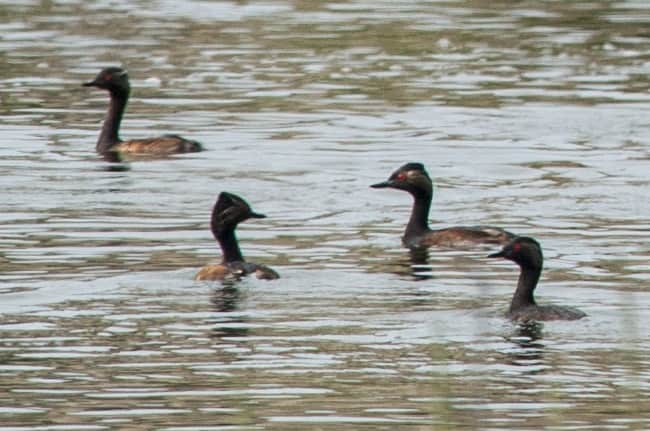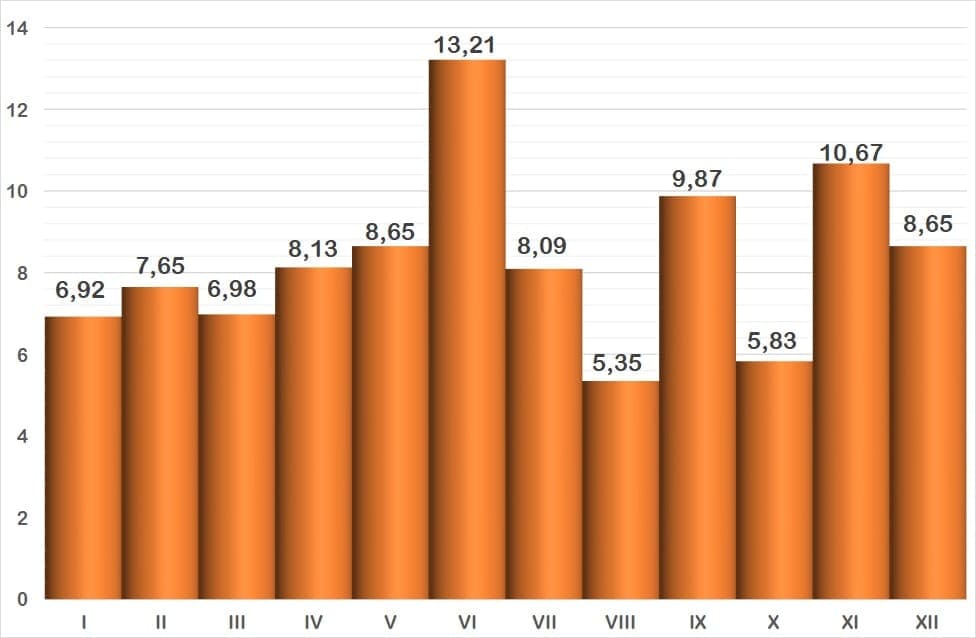It is the medium-sized Grebe seen in Roquetas de Mar, slenderer than the Little Grebe, clearly differentiated in its silhouette by its slimmer and apparently longer neck. It can be distinguished by its forehead, which is also straighter, as well as its long, thin, upturned beak, if we observe it carefully, we will be struck by its red eyes. The appearance in the mating season is dark due to the dominance of black, which goes from its head, down its neck and back, with reddish-brown flanks. There is a distinctive plume of golden feathers on its head, in the shape of a fan which starts just behind the eyes. In winter they retain their black colour, although there is a patch of white feathers, which is repeated on the breast, at this time the flanks become greyish and the shape of the “cottony tassel” of the tail stands out more.

Species 1
Black-necked Grebe
Scientific name
Family 2
Taxonomic Affinity Group 3
Phenology 4
It is a bird which is considered “vulnerable” due to the loss of habitat and habitat quality it has experienced. In the wetlands of Roquetas de Mar it has gone from being a wintering bird to a breeding bird, so its presence in the ‘Salinas de Poniente’ is good news.
It can be seen throughout the year, decreasing during nesting, probably because the birds are incubating and has the greatest presence after reproduction, with a large contribution of individuals that have been born in this and other wetlands. In the postnuptial stage it can also be easily observed, and of course in winter, another very favourable time.

The graph represents the probability of seeing a species during the year, grouped into months. The vertical axis indicates the percentage value. Each of the bars expresses its value. The horizontal axis represents the months: I = January, II = February, III = March, IV = April, V = May, VI = June, VII = July, VIII = August, IX = September, X = October, XI = November and XII = December.
Observation recommendations
It is common to observe them in flocks, which are very numerous in the ‘Salinas Viejas’. In some of the artificial lagoons of Cerrillos it is not uncommon to observe small groups of three to five individuals. In the ‘Gravera’, however, it is certainly much scarcer.
Observation areas where we can find it
Notes
[1] The names used are from the list of birds of Spain, drawn up by SEO/BirdLife and updated to 2019 (https://seo.org/listaavesdeespana/). The reference is: Rouco, M., Copete, J. L., De Juana, E., Gil-Velasco, M., Lorenzo, J. A., Martín, M., Milá, B., Molina, B. & Santos, D. M. 2019. Checklist of the birds of Spain. 2019 edition. SEO/BirdLife. Madrid.
[2] The taxonomic family to which it belongs is indicated.
[3] Traditionally, waterbirds have been grouped according to their taxonomy or “taxonomic affinity”, i.e., when some birds coincide in certain features that allow them to be classified scientifically, but without leaving the rigour of science, they are put together in these groups so that they can be easily recognised. These groups are the following: Greves (belonging to the Podicipedae family), Herons and Similar (includes the families: Ardeidae -Herons- Ciconiidae -Storks- and Threskiornithidae -Ibises and spoonbills-), Ducks (the whole Anatidae family), Coots and Similar (the family Rallidae corresponding to Rails, Gallinules and Coots), Cranes (also with only one family, the Gruidae), Waders , a heterogeneous group, the most diverse of this classification, includes the families Burhinidae (Stone-curlews), Haematopodidae (Oystercather), Recurvirostridade (Avocets and Stilts), Glareolidae (Pranticole), Charadriidadea (Plovers), Scolapacidae and finally Gulls and Similar (the recently unified family Laridae, i.e. Gulls and Terns).
[4] Phenology studies the relationship between the cycles of living beings and meteorological factors, and in our latitude these factors manifest themselves as variations throughout the year, thus relating the seasons to the birds’ cycles (breeding, migratory journeys, etc.) The graph shows the probability of seeing a bird depending on the month. It uses data from 48 bird censuses carried out between October 2016 and September 2018. The method used is that of a census route with sampling stations, with a total count on the sheet of water.
